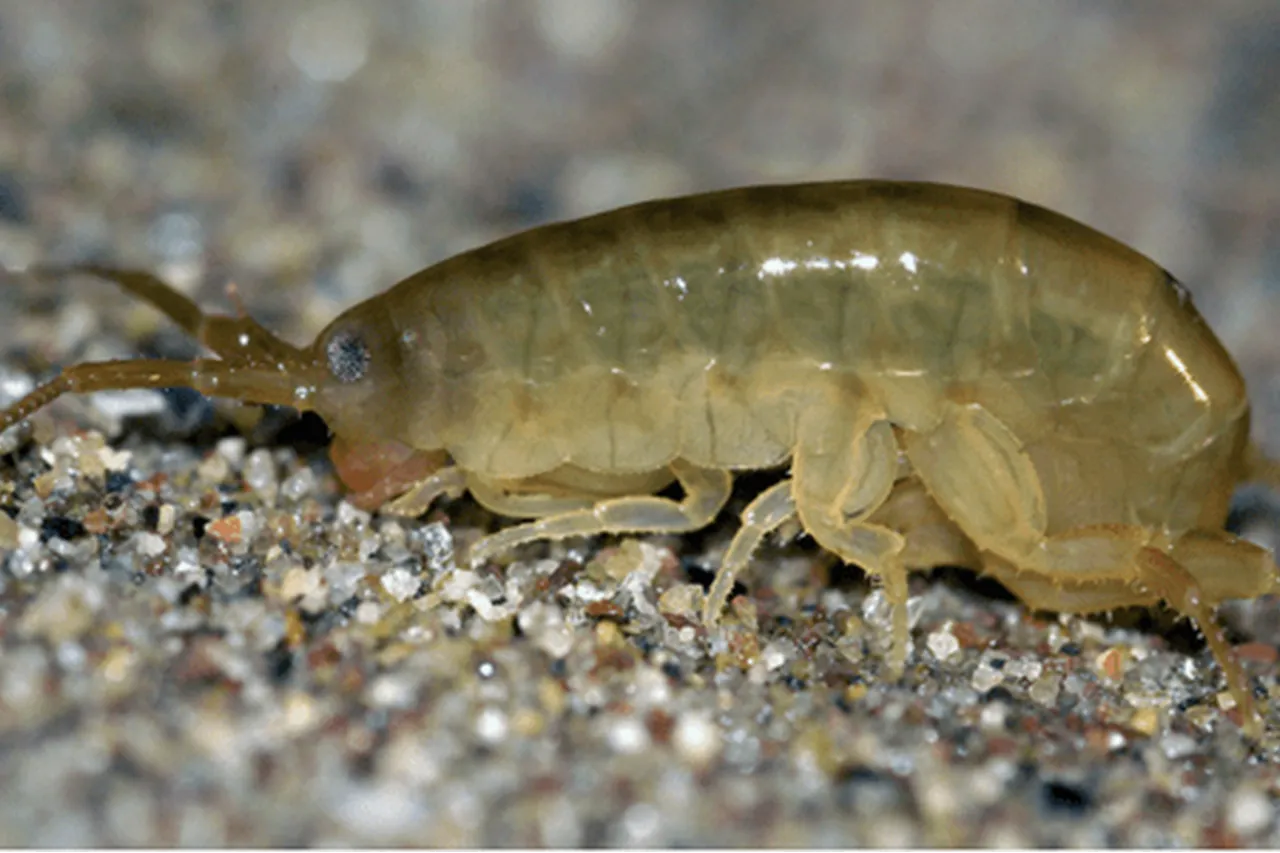Blog
Unmasking Sand Fleas: Behavior, Habitat, and Bite Prevention in Under


Sand fleas, also known as beach hoppers or sand hoppers, may be small in size, but they can cause quite a nuisance for those enjoying a day at the beach. These tiny creatures belong to the crustacean family and are commonly found in sandy coastal areas around the world. With their ability to jump impressive distances, sand fleas can quickly catch unsuspecting beachgoers off guard. In this article, we will delve into the fascinating world of sand fleas, exploring their habits, characteristics, and the measures one can take to avoid their itchy bites. Sand fleas are not actually fleas, but rather amphipods, which are small, shrimp-like crustaceans. They are typically found in sandy areas near the water’s edge, where they burrow into the sand during the day and emerge at night in search of food. Despite their small size, sand fleas have a remarkable ability to leap several inches off the ground, allowing them to move quickly and escape from predators. While they are harmless to humans in most cases, their bites can cause irritation and discomfort, leading to itchy welts that can last for days. In this article, we will explore the life cycle of sand fleas, their feeding habits, and the potential health risks associated with their bites. We will also provide tips on how to prevent sand flea bites and offer suggestions for treating the itchiness and discomfort that may result from an encounter with these tiny beach dwellers. So, let’s dive into the world of sand fleas and learn how to coexist with these fascinating creatures during our beach adventures.
The World of Sand Fleas
Sand fleas, also known as beach hoppers or sand hoppers, are fascinating creatures that inhabit coastal areas worldwide. These tiny crustaceans, scientifically known as amphipods, have adapted to life on the sandy shores and play an essential role in the ecosystem. Here’s a closer look at the world of sand fleas: Habitat and Behavior: Sand fleas primarily reside on sandy beaches and dunes, where they burrow into the sand during the day to avoid predators and extreme temperatures. As nocturnal creatures, they emerge at night to scavenge for food, often feasting on decaying plant matter or other small organisms. This behavior ensures their survival and contributes to nutrient cycling in coastal environments. Types of Sand Fleas: There are several species of sand fleas found in different regions around the world, each with its own unique characteristics and adaptations. While they share the common traits of burrowing and scavenging, specific species may have variations in size, coloration, and preferred habitats. Importance in the Ecosystem: Sand fleas serve as a vital food source for many shore-dwelling animals. They form a significant link in the coastal food web, providing sustenance for shorebirds, fish, and other marine organisms. This interconnectedness highlights the ecological importance of sand fleas and their role in maintaining a balanced ecosystem. Potential Health Risks: While sand fleas are generally harmless to humans, their bites can cause irritation and discomfort. Some individuals may develop allergic reactions to the saliva injected during biting, leading to more severe symptoms. It’s essential to take precautions to prevent sand flea bites, such as wearing protective clothing or applying insect repellent. Future Developments and Trends: As coastal areas face increasing pressures from human activities and climate change, the study of sand fleas and their ecological role becomes more important. Researchers are exploring how changes in temperature, sea levels, and coastal development may impact sand flea populations and their interactions with other organisms. This knowledge is crucial for effective conservation and management strategies. Notable Variations and Related Concepts: While sand fleas are the focus of this discussion, it’s worth mentioning related concepts such as sand flies and sand mites, which are separate organisms with different characteristics and behaviors. These distinctions highlight the diversity of creatures that inhabit sandy environments and contribute to the intricate web of life found on our coasts.Characteristics of Sand Fleas
Sand fleas, also known as beach hoppers or sand hoppers, are fascinating creatures with unique characteristics that help them thrive in their sandy habitats. Here are some key characteristics of sand fleas:- Appearance: Sand fleas are small crustaceans, measuring about 10-20 millimeters in length. They have elongated bodies covered in a hard exoskeleton, which helps protect them from the shifting sands.
- Habitat: Sand fleas are predominantly found in coastal areas with sandy beaches. They are highly adapted to this environment, as their flattened bodies and powerful legs enable them to move quickly through the sand.
- Behavior: Sand fleas are nocturnal creatures, burrowing into the sand during the day to escape the heat and potential predators. At night, they emerge to scavenge for organic matter and detritus, which they feed on.
- Reproduction: Sand fleas have complex mating rituals, with males competing for the attention of females. After fertilization, females carry their eggs in a specialized pouch until they hatch, releasing miniature versions of themselves into the sand.
- Ecosystem Role: Sand fleas play an important role in the coastal ecosystem as a food source for other animals, such as shorebirds and fish. Their burrowing activities also help to aerate the sand and break down organic matter.
Behavior and Habitat of Sand Fleas
Sand fleas, also known as beach hoppers or sand hoppers, are fascinating creatures with unique behavior and specific habitat preferences. Understanding their behavior and habitat is crucial to appreciate their role in the coastal ecosystem and develop effective conservation strategies. Behavior:- Sand fleas are primarily nocturnal, meaning they are most active at night. During the day, they seek refuge by burrowing into the sand, blending in with their surroundings.
- At night, sand fleas emerge from their burrows to scavenge for food. They are omnivorous, feeding on decaying organic matter, algae, and sometimes even smaller animals.
- These tiny crustaceans have a remarkable jumping ability. They use their long hind legs to catapult themselves into the air, propelling themselves several inches off the ground.
- Sand fleas inhabit sandy shorelines, particularly coastal and intertidal zones. They thrive in areas with a mix of sand and moisture, allowing them to burrow easily and access their necessary food sources.
- They are commonly found on sandy beaches, dunes, and marshes. These habitats provide the ideal conditions for sand fleas to survive and reproduce.
Sand Flea Bites: Causes and Symptoms
Sand flea bites can be quite bothersome and can cause discomfort for those who are unfortunate enough to experience them. As the name suggests, sand fleas are the culprits behind these bites, and they are not actually fleas but rather crustaceans known as amphipods. Causes of Sand Flea Bites: Sand flea bites occur when these tiny creatures come into contact with human skin. They are attracted to the warmth and carbon dioxide emitted by our bodies. When they bite, they inject saliva into the skin, which contains histamines that can cause an allergic reaction in some individuals. Symptoms of Sand Flea Bites: The symptoms of sand flea bites can vary from person to person. Some common symptoms include:- Itching and redness around the bite area
- Raised bumps or welts resembling mosquito bites
- Small blisters filled with clear fluid
- Intense itching, sometimes leading to secondary infections if scratched excessively
- Use insect repellents that contain DEET or picaridin on exposed skin.
- Wear long sleeves, pants, and closed-toe shoes when in sandy areas.
- Avoid sitting or lying directly on the sand.
- Shake out towels or blankets before use to remove any hiding sand fleas.
- Wash the affected area with mild soap and water to prevent infection.
- Apply an over-the-counter hydrocortisone cream to reduce itching and inflammation.
- Take an antihistamine to relieve itching and allergic reactions.
- Avoid scratching the bites, as this can lead to further irritation and possible infection.
Prevention and Treatment of Sand Flea Bites
Sand flea bites can cause discomfort and irritation, but there are ways to prevent them and alleviate their effects. Here are some important tips for preventing and treating sand flea bites:Prevention:
- Use insect repellents containing DEET or picaridin to deter sand fleas.
- Wear protective clothing, such as long sleeves and pants, when spending time in sandy areas.
- Avoid direct contact with sand by using a towel or beach chair.
- Consider applying sunscreen before insect repellent, as the latter may reduce the effectiveness of the former.
- If bitten, wash the affected area with soap and water to remove any remaining saliva.
- Apply a cold compress or ice pack to relieve itching and reduce swelling.
- Over-the-counter antihistamine creams or oral antihistamines can help alleviate allergic reactions.
- Corticosteroid creams or oral medications may be prescribed for severe symptoms or allergic reactions.
Conclusion
Understanding the behavior and habitat of sand fleas is crucial for effective conservation strategies. Sand fleas, also known as beach hoppers or sand hoppers, are primarily nocturnal creatures that burrow into the sand during the day and emerge at night to scavenge for food. They inhabit sandy shorelines, including sandy beaches, dunes, and marshes, particularly in coastal and intertidal zones. It is important to note that sand fleas are not actually fleas, but crustaceans called amphipods. Their bites occur when they come into contact with human skin and inject saliva that contains histamines, causing an allergic reaction in some individuals. Symptoms of sand flea bites can include itching, redness, raised bumps, and blisters. To prevent sand flea bites, it is advisable to use insect repellents and avoid direct contact with sand. If bitten, washing the affected area, applying cold compresses or ice packs, using antihistamine creams or oral medications can help alleviate discomfort. Seek medical attention if symptoms persist or worsen. Ongoing research is being conducted to better understand the impact of human activities and climate change on sand flea populations. By gaining more knowledge about these fascinating creatures, we can work towards their conservation and coexistence with humans in coastal environments.Frequently Asked Questions
Q: What are sand fleas?
Sand fleas, also known as beach hoppers or sand hoppers, are nocturnal crustaceans that burrow into the sand during the day and scavenge for food at night. They have a remarkable jumping ability and are omnivorous.Q: Where do sand fleas live?
Sand fleas inhabit sandy shorelines, particularly coastal and intertidal zones. They are commonly found on sandy beaches, dunes, and marshes.Q: Are sand fleas the same as sand flies and sand mites?
No, sand fleas are different from sand flies and sand mites. Sand fleas are crustaceans known as amphipods.Q: What are the causes and symptoms of sand flea bites?
Sand flea bites occur when the creatures come into contact with human skin and inject saliva containing histamines. The symptoms can include itching, redness, raised bumps, and blisters.Q: How can I prevent sand flea bites?
To prevent sand flea bites, it is recommended to use insect repellents and avoid direct contact with sand.Q: What are the treatment options for sand flea bites?
Treatment options for sand flea bites include washing the affected area, applying cold compresses or ice packs, using antihistamine creams or oral medications, and seeking medical attention if symptoms persist or worsen.Recent Posts
BlockDAG And Best Wallet Presale Participants Receive Free Skyren DAO Airdrop
Token airdrops have historically introduced investors to new blockchain projects. However, many distributions fail to…
2 weeks ago
Skyren DAO Token Surge Event: Remittix And Lightchain AI Communities First To Benefit
Airdrops have traditionally been used to introduce new investors to blockchain projects, but their effectiveness…
2 weeks ago
Bitcoin ETF Approval? Old News. Here’s Why Skyren DAO Could Outperform BTC 10-fold
The approval of Bitcoin ETFs was one of the most anticipated events in crypto history,…
2 weeks ago
Qubetics And Rexas Finance Holders: Claim Your 500 Free SKYRN Tokens Now
The blockchain space continues to evolve, with projects pushing security, scalability, and user engagement to…
2 weeks ago
Cardano Skyren DAO And Remmitix Potential Highlighted As Market Optimism Rises
As the cryptocurrency market recovers from recent volatility, several projects emerge as strong contenders for…
3 weeks ago
Cardano And Litecoin Ready To Rally: Analysts Predict 10x Gains For This Newcomer
The cryptocurrency market is showing strong bullish signals, with many altcoins poised for significant gains.…
3 weeks ago


